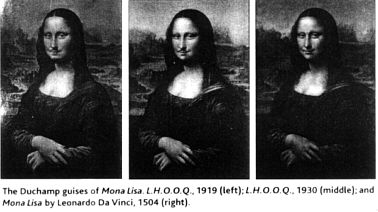Marcel Duchamp's intentions lie revealed in an inadverdent, but but highly amusing and equally instructive error in the figure of L.H.O.O.Q. (a moustached and bearded Mona Lisa) that illustrates Barry Cipra's News Focus article "Duchamp and Poincaré renew an old acquaintance" (26 Nov., p. 1668). Cipra discusses analyses by R.R. Shearer and R. Brandt (1) that Duchamp's infamous L.H.O.O.Q. of 1919--his supposedly simple "desecration" of festooning an image of the Mona Lisa with a moustache, a beard, and a salacious title (the letters spoken in French sound like the sentence "She has a hot ass")--actually represents Duchamp's more subtle and complex manipulation of creating his own lithographic reproduction by making a composite of his face with Leonardo's La Giaconda. (In so doing, we presume, Duchamp wished to expose the foibles of art critics and historians by showing that he could so alter their most famous icon, and they would not notice so long as he distracted them by an outrageous graffito and a plausible Dada claim for why he had done so).
 Duchamp festooned at least 12 other versions of the Mona Lisa throughout his career, all
presumably as part of a plan for hinting toward his intentions, and displaying the power
of tiny alterations on general themes (if only we could free our mind of expectations,
and learn to observe closely). But from comparisons of measurements of the facial
features, Shearer and Brandt (1) have concluded that all these other mustachioed
Monas differ from the original 1919 version in a crucial way. In fact, the other versions
all use unaltered reproductions of Leonardo's famous painting. Only Duchamp's 1919 original
(and the replica that he produced later for the portable and miniaturized "museum"
of his oeuvre the Bôite-en-Valise) features the composite of his face and Leonardo's
Mona Lisa. In Cipra's article, the top image on page 1669 is described as the 1919 original, but it
actually represents Duchamp's first "replication" of 1930, using Leonardo's unaltered
painting. Interestingly, Duchamp did not exhibit the original 1919 work in public until 1930,
when he posted both versions, side by side, in a gallery, perhaps as a dare or a challenge.
Duchamp festooned at least 12 other versions of the Mona Lisa throughout his career, all
presumably as part of a plan for hinting toward his intentions, and displaying the power
of tiny alterations on general themes (if only we could free our mind of expectations,
and learn to observe closely). But from comparisons of measurements of the facial
features, Shearer and Brandt (1) have concluded that all these other mustachioed
Monas differ from the original 1919 version in a crucial way. In fact, the other versions
all use unaltered reproductions of Leonardo's famous painting. Only Duchamp's 1919 original
(and the replica that he produced later for the portable and miniaturized "museum"
of his oeuvre the Bôite-en-Valise) features the composite of his face and Leonardo's
Mona Lisa. In Cipra's article, the top image on page 1669 is described as the 1919 original, but it
actually represents Duchamp's first "replication" of 1930, using Leonardo's unaltered
painting. Interestingly, Duchamp did not exhibit the original 1919 work in public until 1930,
when he posted both versions, side by side, in a gallery, perhaps as a dare or a challenge.
Incidentally, your illustration showing Duchamp's masterpiece the Large Glass (p. 1668) appears "flopped" (that is, turned by 180 degrees in printing from a reversed negative), another illustration of errors so easily made with "objective" visual information.
Stephen Jay Gould*
*President of AAAS.
References
1. R.R. Shearer and R. Brandt, paper presented at the conference "Methods of
Understanding in Art and Science: The Case of Duchamp and Poincaré,"
Harvard University, Cambridge, MA, 5 to 7 November 1999